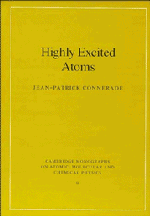Book contents
- Frontmatter
- Contents
- Preface
- 1 Closed shells, sphericity, stability and ‘magic numbers’
- 2 Rydberg states
- 3 Quantum defect theory for bound states
- 4 Atomic f values
- 5 Centrifugal barrier effects
- 6 Autoionisation
- 7 Inner-shell and double-excitation spectra
- 8 K-matrix theory of autoionising resonances
- 9 Atoms in strong laser fields
- 10 Statistical methods and ‘quantum chaology’
- 11 Atomic effects in solids
- 12 Atomic clusters
- References
- Index
11 - Atomic effects in solids
Published online by Cambridge University Press: 19 September 2009
- Frontmatter
- Contents
- Preface
- 1 Closed shells, sphericity, stability and ‘magic numbers’
- 2 Rydberg states
- 3 Quantum defect theory for bound states
- 4 Atomic f values
- 5 Centrifugal barrier effects
- 6 Autoionisation
- 7 Inner-shell and double-excitation spectra
- 8 K-matrix theory of autoionising resonances
- 9 Atoms in strong laser fields
- 10 Statistical methods and ‘quantum chaology’
- 11 Atomic effects in solids
- 12 Atomic clusters
- References
- Index
Summary
Introduction
There are many connections between the physics of free atoms and that of solids which have been noted, in passing, several times already in the present volume. One should add that many-body theory and, especially, the concept of excitations as quasiparticles in free atoms, owe much to the theory of excitations in solids [590].
The theme of the present chapter is rather more specific: the intention is to present a number of effects which are counterparts of those we have studied in previous chapters, but for atoms in the solid rather than in the gaseous phase. Also, the intention is to set the scene for the last chapter, in which atomic clusters will be used in an attempt to bridge the gap from the atom to the solid experimentally. A highly excited atom in a solid will be taken as an atom excited close to or above the Fermi energy (including, of course, core excitation). There are some solid state systems for which electrons with energies close to the Fermi level behave like those in atoms. X-ray absorption and electron energy loss spectroscopy involving core excitation to empty electronic states can then be described by initial and final states possessing L, S and J quantum numbers, and the allowed transitions follow strict dipole selection rules. Examples include the d → f transitions of Ba in high Tc superconductors, and many instances involving transition metals and lanthanides.
- Type
- Chapter
- Information
- Highly Excited Atoms , pp. 403 - 428Publisher: Cambridge University PressPrint publication year: 1998



